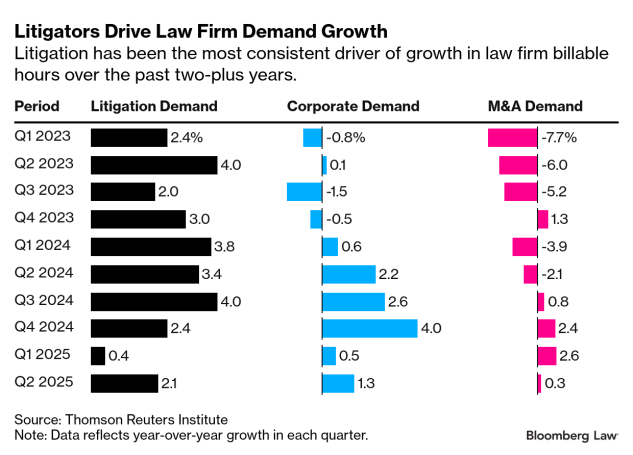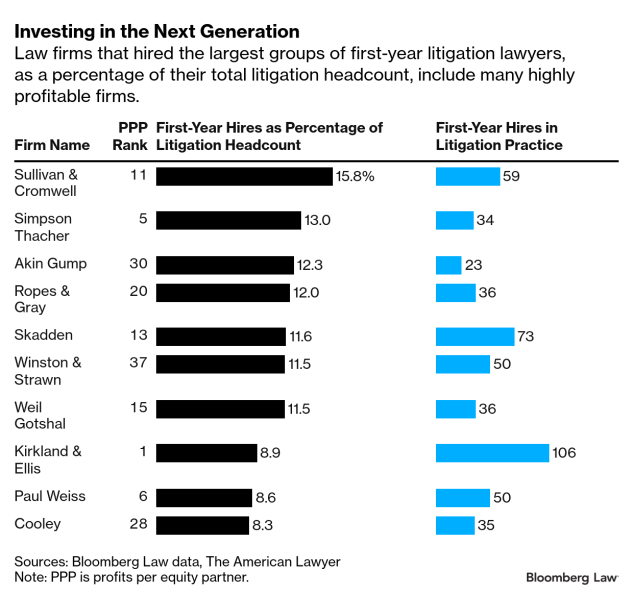Some of the largest and most profitable law firms are aggressively growing their litigation rosters, new data from Bloomberg Law show.
Four firms—Kirkland & Ellis, Paul Weiss, Davis Polk, and Paul Hastings—grew their litigation headcount by at least 22% since the beginning of last year. Those firms also are among the country’s 12 most profitable, climbing the ranks largely on the strength of their corporate and transactional practices.
“We did not anticipate that litigation would be the driving factor from a demand standpoint this year,” said Owen Burman, a senior consultant in Wells Fargo’s legal banking group.
The numbers build on industry reports showing litigation, not M&A or other deals work, as the most powerful source of demand growth for firms since at least 2023. They show that even some firms focused on dominating the deals arena have received a message: Ignore litigation departments at your own peril.
The courtroom practice is mostly immune to the types of spikes and valleys that transactions practices experience. It can be just as profitable as deals work when managed correctly, firm leaders said.
“We really do have this focus on diversification, and taking a portfolio approach to our practices,” said Frank Lopez, chair of Paul Hastings, where litigation revenue has risen 60% over the last four years. “In a softer market, litigation is either cycle agnostic or countercyclical. It’s incredibly stabilizing. And even in a good market, it’s important for us to drive revenue.”
The data cover the 50 largest US law firms by revenue. Forty of those firms provided litigation headcounts, while tallies for the rest were based on data provided by Firm Prospects.
As a group, the top 50 law firms by revenue increased its headcount of litigators by a net 5.3% during that time.
Deals Hangover
Big Law as an industry has spent roughly a decade building up its capability to service private equity clients and the immense number of transactions they execute. The trend helped drive firms such as Kirkland and Latham & Watkins into behemoths.
The tide has receded since a pandemic-era peak, when transactions hit new volume records and firms scrambled to hire lawyers to field the work. Despite a recent string of mega deals, the overall transactions volume remains relatively stagnant. Private equity in particular has struggled to offload portfolio companies at historical rates. The number of global private equity deals in 2023 and 2024 remained below levels not seen since 2018, according to Bloomberg data.
Litigation became the most consistent driver of demand for lawyers’ time starting as early as 2023, according to data from Thomson Reuters Institute. The number of hours billed by litigation practices grew for 10 consecutive quarters on a year-over-year basis. The courtroom practice averaged 2.8% demand growth per quarter over that time, while M&A work has declined by an average of 1.8%.
Kirkland, whose litigator headcount spiked by nearly a third since last year, has made a concerted push to build its mass torts and products liability defense practice. Other firms that spoke with Bloomberg Law about their growth in litigation didn’t specify any common type of cases that is leading the demand growth.
“The message is clear: For high-end, bet-the-company litigation, the demands are increasing,” said Michael Carlinsky, co-managing partner of Quinn Emanuel. “And they have been, year-over-year, for the last three or four years.”
Carlinsky’s firm, which exclusively does litigation work, brought in nearly $2.5 billion in revenue last year. Quinn Emmanuel was the country’s 18th largest law firm by revenue, up 10 spots over three years.
Cooley LLP is among the 12 Big Law firms to grow litigation headcount more than 10% since the start of last year. The tech-heavy, West Coast-founded firm suffered one of the largest hangovers from the binge in pandemic deals. It laid off 150 attorneys and staff at the end of 2022, primarily from transactional practices.
Still, the firm has long looked to increase its litigation headcount to better serve its evolving clientele. Cooley in 2019 began to balance the size of its East Coast litigation practice with its West Coast litigators, said Ian Shapiro, chair of its global litigation group. The firm has about 100 litigators on each coast.
“At the very top of our firm, it’s a strategic imperative for us to have the greatest degree of balance possible between our corporate and transactional and litigation businesses,” he said.
Profitability Drag?
Despite the aggressive moves by some high-profit firms, major law firms as a group have failed to grow their litigation departments to the size they were before the pandemic.
Litigators were more than 30% of lawyers at the most profitable firms in 2019, according to a study by Citi Global Wealth’s Law Firm Group. That figure dipped to 27.2% in 2022 before recovering slightly to 28.8% in 2024.
Conventional wisdom in the legal industry states litigation simply is less profitable than corporate practices. That’s not necessarily true, says Gretta Rusanow, head of advisory services at the Citi law firm group.
Citi found that a group with the second-highest concentration of litigators was also the second-most profitable. The firms accomplished that by maintaining high productivity and realization rates, debunking a common critique that litigation practices collect a lower share of their bills.
“It bucks the convention that having a heavy dependence on litigation is a drag on your profitability,” Rusanow said.
Targeting First-Years
The view that litigation is less profitable has created opportunities for firms investing in the practice.
Sheppard Mullin has hired partners from rivals that didn’t support their litigation groups, according to the firm’s practice leaders. The firm grew its business trial litigation group by more than 17% from 2024 through the third quarter, the Bloomberg Law data show, landing in fifth place on the growth chart.
“One of the ways in which partners at firms feel they’re not supported is the firm is not hiring entry-level associates or appropriately staffing their offices,” Sascha Henry, who co-leads the firm’s practice group, said. “Those are things we feel really strongly about and are committed to.”
Thirty-three of the top 50 law firms provided hiring data for first-year associates in their litigation groups. The country’s most profitable law firms again led the pack.
The firms that hired the largest first-year litigation classes—as a percentage of their total litigation headcount—included Sullivan & Cromwell, Simpson Thacher, Akin Gump, Ropes & Gray, and Skadden.
Six of the 10 firms leading the way are in the top 15 when ranked by profits per equity partner.
Paul Hastings was not among the most active recruiters of first-year litigators, but the firm has been adding lateral partner hires even as its splashy recruiting in the private credit and public company M&A practices make headlines. Litigation work is just as profitable for the firm as corporate transactions, according to Lopez.
“The litigation department isn’t supporting the corporate department or vice versa,” he said. “The economics are consistent across the board.”
To contact the reporter on this story:
To contact the editors responsible for this story:
Learn more about Bloomberg Law or Log In to keep reading:
See Breaking News in Context
Bloomberg Law provides trusted coverage of current events enhanced with legal analysis.
Already a subscriber?
Log in to keep reading or access research tools and resources.


